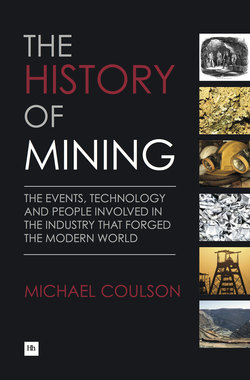Читать книгу The History of Mining - Michael Coulson - Страница 33
На сайте Литреса книга снята с продажи.
Оглавление1. Introduction
The ancient world presents a patchwork of contrasts. Over the centuries great technological strides were made by the Romans and the Chinese, only for massive geo-political events in Europe in the Medieval period – such as the rise of the Visigoths and the Vikings – to throw the whole process into reverse. So the developments in hygiene, water, heating and sewage that the Romans had tackled so successfully were lost and the consequences in terms of public health breakdown returned time and again over the centuries to threaten civilisation.
In such circumstances of uncertainty it is not surprising that technological innovation and thus economic advance were so modest. This uncertainty was materially fuelled by continuing political upheaval and in consequence almost permanent conflict. Thus for centuries the demand for metals was driven by the demand for weapons. As the Middle Ages advanced there were some signs that this baleful trend might give way to something more constructive, although as we know to our cost today war and conflict is never very far away, even in times of economic growth and relative peace.
It is accepted that historians disagree in their interpretation of events. In the case of defining the Middle Ages period, we have, as you will have noted, chosen our start date as the Norman invasion of Britain in 1066. As we stated in the previous section on the ancient world, the period from the fall of the Roman Empire to 1066 can be described as the Medieval period, although for many historians the period goes on for a further three centuries. Following that, Europe in particular started something of a revival based on economic growth associated with an accelerating increase in population.
The Middle Ages was also a time of resumed technological advance, which was particularly helpful to the mining industry where deeper mines and growing production required new ways of working to be developed. Initially miners in Europe in the early Middle Ages had enjoyed something of a golden period – in the 12th and 13th centuries miners in Italy, through the Treaty of Trent, and in Germany and England, had their rights to minerals they found, subject to royalties, enshrined in law. But the onset of deeper and bigger mines meant this phase of mining industry development by small scale owner-miners was relatively short-lived.
Developments in mine finance
At the same time as the mines got bigger, in an age where slave labour was no longer as widely used as in the past, these old miner-financed operations were in decline as more sophisticated forms of finance were developed. In particular in Germany (Saxony and Bohemia) mine finance using capital provided by non-participants emerged; the concept of buying equity in a mine, thus spreading the financing risk and drawing dividends from surpluses earned, caught on. The initial idea was that the shareholders would be close to the mine and meet frequently to be briefed as to how things were going. In due course the meetings got less frequent and the shareholders became more remote from the mine, a pattern for what happens today in publicly listed shareholder owned companies, and perhaps an inevitable development.
This new structure also meant that the old link between the miner and direct rewards for his efforts was broken. This historic arrangement had often had the backing of the mineral rights owner, aristocrat or landed gentry, and the miner in essence shared the rewards of his efforts with the owner. Once that structure had been changed the miner more often than not became an employee of the companies who increasingly owned and managed the mines.
Society and technology
The Middle Ages also contained events of great political and cultural importance – the Reformation and the Renaissance are two major examples of events that helped put Europe back on the map in terms of power and influence. But there were also great disasters to overcome. The Black Death in the mid-14th century unsurprisingly slowed progress right down and had a profound impact on economic activity for decades. Despite that, the march of technology was bringing Europe back to where it had been when the Roman Empire had been at its zenith. In mining, the use of water power for pumping and treatment had been refined to increase efficiency and on the treatment front the blast furnace allowed substantially increased throughput in the smelting process.
A body of literature and research on mining and metallurgy was also being built up during this period; perhaps the best-known writer was Georgius Agricola, who we highlight below. Other observers included two Arab alchemists whose westernised names were Geber and Avicenna and who lived and worked in the 9th and 11th centuries respectively; the 13th century philosopher Albertus Magnus who wrote De Mineralibus; and the 16th century Venetian alchemist Aurelio Augurelli.
Much of the thinking in those days was based on the theory of alchemy and held that metals, having been expelled from the core of the earth, were trapped in veins and fissures and then went through a process of cooling followed by steady transmutation into higher metal forms over the centuries – so base metals would eventually become gold and silver. These theories lasted until the 17th century when slowly but surely thinking began to change as the age of modern chemistry dawned.
